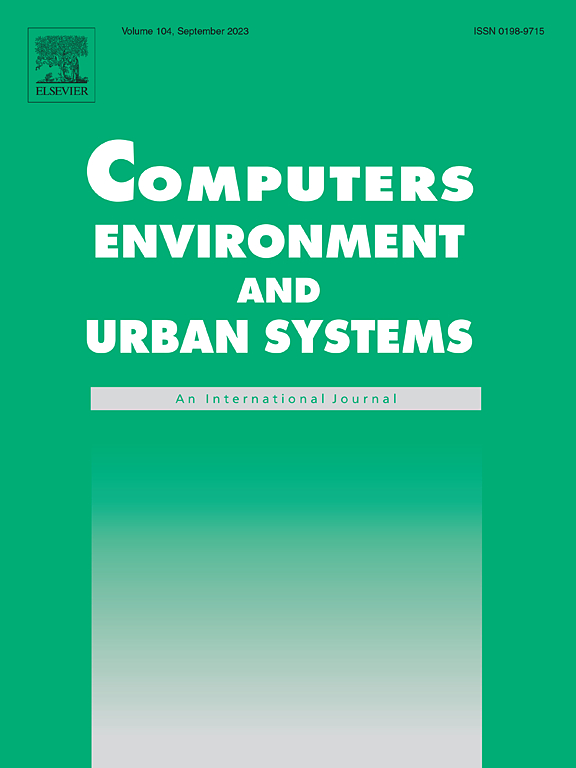白天和夜间热点的同质性和异质性及其对热弹性城市规划中协同缓解的影响
IF 8.3
1区 地球科学
Q1 ENVIRONMENTAL STUDIES
Computers Environment and Urban Systems
Pub Date : 2024-12-14
DOI:10.1016/j.compenvurbsys.2024.102241
引用次数: 0
摘要
许多城市面临着严峻的高温挑战,带来了严重的环境、社会和经济后果,引发了人们对耐热城市规划的极大关注,但通常对有限的(例如,白天的)缓解需求有偏见。特别是,认识到城市热热点对于增加有效的降温干预措施以缓解和避免新建地区过热至关重要。然而,热点和相关驱动因素随时间和空间的变化而变化,这给城市规划者带来了挑战,他们需要做出双赢的决策,通过一套综合的冷却策略来同步解决昼夜热应激。本研究旨在通过开发一种强大的方法方案来解决与温度数据和分析模型相关的不确定性,从而认识到昼夜热点和夜间热点的同质性和异质性,并解释其背后的主要和协同驱动因素。它明确地(1)使用严格筛选的卫星数据确定夏季白天和夜间热点;2)根据城市构成、形态和功能,识别出热点易发城市景观的典型类型;3)通过多模型非线性分析,结合随机森林、梯度增强机和增强回归树等多种机器学习技术,探索城市主要因子的昼夜相似性和差异性及其鲁棒有效范围。结果表明,白天和夜间热点的具体位置和典型城市景观特征存在差异。在六种类型中,工业主导的类型更倾向于成为昼夜热点,而土地用途多样化(主要以住宅为主)的中高层和中密度街区更倾向于成为昼夜热点,更有可能成为夜间热点。三种模型都得出了强有力的结论,即城市形态对昼夜热点的形成都有显著影响。虽然在许多情况下,权衡仍然是不可避免的,但对于中国武汉,通过优化建筑平均高度低于15米或高于25米,建筑体积密度低于2%,可以实现协同缓解。总体而言,本研究响应了新兴的多维城市科学和实践,并将传统的针对城市高温的一维规划扩展到针对白天和夜间热点的双赢决策。实证研究结果有助于制定全面、公正和可实施的增强气候适应能力的行动。本文章由计算机程序翻译,如有差异,请以英文原文为准。
Homogeneity and heterogeneity of diurnal and nocturnal hotspots and the implications for synergetic mitigation in heat-resilient urban planning
Many cities are under intense heat challenges with severe environmental, social, and economic consequences, sparking great concern on heat-resilient urban planning, yet normally with biased focus on limited (e.g., diurnal) mitigation needs. Particularly, the recognition of urban thermal hotspots is crucial for adding effective cooling interventions for mitigation and avoiding overheating in newly built areas. However, the hotspots and associated drivers vary across time and space, bringing challenges to urban planners to make win-win decisions to synchronously address diurnal and nocturnal heat stresses through an integrated set of cooling strategies. This study aims to recognize the homogeneity and heterogeneity of diurnal and nocturnal hotspots and interpret principal and synergetic drivers behind them by developing a robust methodological scheme in addressing uncertainties associated with temperature data and analytical models. It explicitly 1) identified summer diurnal and nocturnal hotspots using rigorously screened satellite data; 2) recognized the typical typologies of hotspot-prone urban landscape according to urban composition, morphology, and function; 3) explored the day-night similarities and disparities in major urban factors and their robust effective ranges for synergetic mitigation through multi-model non-linear analysis with diverse machine learning techniques covering random forest, gradient boosting machines, and boosted regression trees. Results revealed that the specific locations and typical urban landscape features varied between diurnal and nocturnal hotspots. Among the six typologies recognized, industrial-dominated ones were more inclined to emerge as diurnal hotspots, while mid- to high-rise and mid-density blocks, with diversified land uses (mostly residential-dominated), tended to become diurnal, and more likely, nocturnal hotspots. All three models reached robust conclusion that urban morphology exhibited significant influence on both diurnal and nocturnal hotspot formation. Although trade-offs remained unavoidable in many cases, synergetic mitigation could be achieved through optimizing area averaged building height below 15 m or above 25 m, and building volume density under 2 % for Wuhan, China. Overall, this study responds to the emerging multidimensional urban science and praxis and extends the conventional one-dimensional planning against urban heat to win-win decisions over both diurnal and nocturnal hotspots. The empirical findings can benefit the development of complete, unbiased, and implementable actions for enhanced climate-resilience.
求助全文
通过发布文献求助,成功后即可免费获取论文全文。
去求助
来源期刊

Computers Environment and Urban Systems
Multiple-
CiteScore
13.30
自引率
7.40%
发文量
111
审稿时长
32 days
期刊介绍:
Computers, Environment and Urban Systemsis an interdisciplinary journal publishing cutting-edge and innovative computer-based research on environmental and urban systems, that privileges the geospatial perspective. The journal welcomes original high quality scholarship of a theoretical, applied or technological nature, and provides a stimulating presentation of perspectives, research developments, overviews of important new technologies and uses of major computational, information-based, and visualization innovations. Applied and theoretical contributions demonstrate the scope of computer-based analysis fostering a better understanding of environmental and urban systems, their spatial scope and their dynamics.
 求助内容:
求助内容: 应助结果提醒方式:
应助结果提醒方式:


